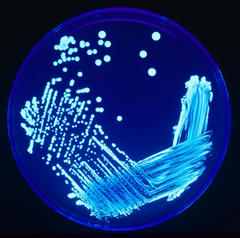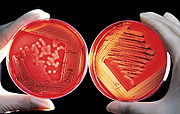
Streaking (microbiology)
Encyclopedia

Microbiology
Microbiology is the study of microorganisms, which are defined as any microscopic organism that comprises either a single cell , cell clusters or no cell at all . This includes eukaryotes, such as fungi and protists, and prokaryotes...
, Streaking is a technique used to isolate a pure strain from a single species of microorganism, often bacteria
Bacteria
Bacteria are a large domain of prokaryotic microorganisms. Typically a few micrometres in length, bacteria have a wide range of shapes, ranging from spheres to rods and spirals...
. Samples can then be taken from the resulting colonies and a microbiological culture
Microbiological culture
A microbiological culture, or microbial culture, is a method of multiplying microbial organisms by letting them reproduce in predetermined culture media under controlled laboratory conditions. Microbial cultures are used to determine the type of organism, its abundance in the sample being tested,...
can be grown on a new plate so that the organism can be identified, studied, or tested.
The streaking is done using a sterile tool, such as a cotton swab or commonly an inoculation loop
Inoculation loop
An inoculation loop, also called a smear loop, inoculation wand or microstreaker, is a simple tool used mainly by microbiologists to retrieve an inoculum from a culture of microorganisms. The loop is used in the cultivation of microbes on plates by transferring inoculum for streaking.The wire forms...
. This is dipped in an inoculum such as a broth or patient specimen containing many species of bacteria.
The sample is spread across one quadrant of a petri dish
Petri dish
A Petri dish is a shallow glass or plastic cylindrical lidded dish that biologists use to culture cells or small moss plants. It was named after German bacteriologist Julius Richard Petri, who invented it when working as an assistant to Robert Koch...
containing a growth medium
Growth medium
A growth medium or culture medium is a liquid or gel designed to support the growth of microorganisms or cells, or small plants like the moss Physcomitrella patens.There are different types of media for growing different types of cells....
, usually an agar plate
Agar plate
An agar plate is a Petri dish that contains a growth medium used to culture microorganisms or small plants like the moss Physcomitrella patens.Selective growth compounds may also be added to the media, such as antibiotics....
which has been sterilized in an autoclave
Autoclave
An autoclave is an instrument used to sterilize equipment and supplies by subjecting them to high pressure saturated steam at 121 °C for around 15–20 minutes depending on the size of the load and the contents. It was invented by Charles Chamberland in 1879, although a precursor known as the...
. Choice of which growth medium is used depends on which microorganism is being cultured, or selected for. Growth media are usually forms of agar
Agar
Agar or agar-agar is a gelatinous substance derived from a polysaccharide that accumulates in the cell walls of agarophyte red algae. Throughout history into modern times, agar has been chiefly used as an ingredient in desserts throughout Asia and also as a solid substrate to contain culture medium...
, a gelatinous substance derived from seaweed.

Dependant on the strain, the plate may then be incubated, usually for 24 to 36 hours, to allow the bacteria to reproduce. At the end of incubation there should be enough bacteria to form visible colonies in the areas touched by the inoculation loop. From these mixed colonies, single bacterial or fungal species can be identified based on their morphological (size/shape/colour) differences, and then sub-cultured to a new media plate to yield a pure culture for further analysis.
Automated equipments are used at industrial level for streak plating the solid media in order to achieve better sterilization and consistency of streaking and for reliably faster work. While streaking manually it is important to avoid scratching the solid medium as subsequent streak lines will be damaged and non-uniform deposition of inoculum at damaged sites on the medium yield clustered growth of microbes which may extend into nearby streak lines.
External links
- Streaking agar plate method for getting isolated colonies (video).

